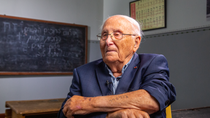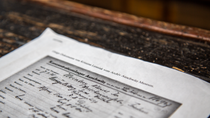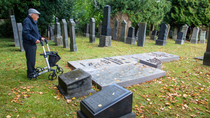Ludwigshafen
Prisoner 116 927
Contemporary witness Albrecht Weinberg tells his story.
One that must not be repeated.
All over the world, victims of the Holocaust are remembered every year on January 27 – the anniversary of the day in 1945 when Soviet soldiers liberated the Auschwitz concentration and extermination camp in occupied Poland. To commemorate International Holocaust Remembrance Day, colleagues from the “Remember. Reflect. Rethink” initiative spoke to Albrecht Weinberg, one of the last survivors of the I.G. Farben concentration camp in Auschwitz.
September 2022: Albrecht Weinberg is sitting in a comfortable blue armchair in the smart living room of his home in Leer, East Frisia. The 97-year-old has his walking frame close at hand. Strong East Frisian tea is served in delicate teacups, accompanied by kluntjes – white pieces of rock sugar the size of marbles. A CD of Jewish songs is playing in the background. Gerda Dänekas (73) has baked a lemon cake and expertly adds the obligatory spoonful of whipped cream to everyone’s tea. She is not only Weinberg’s carer, but also his housemate. Nothing about this cozy atmosphere hints at the horrors, the terror, the fight for survival that shaped Weinberg’s early childhood and youth.

Albrecht Weinberg in September 2022 at the former Jewish school in Leer.

Excerpt from Albrecht Weinberg's prisoner file (Source: Auschwitz Museum).
The vise closes
March 1925: Weinberg was born in Westrhauderfehn, just a few kilometers from where he lives now, as the third and youngest child of a Jewish family. At Christmas he sang carols with his neighbors around their tree; his friends joined his family in celebrating Hanukkah. The communities got on well – but this harmony came to an abrupt end a few weeks before Weinberg’s eighth birthday, when Hitler came to power. The Weinbergs were transformed from respected neighbors to enemies overnight. Weinberg’s father, a livestock trader, was no longer permitted to practice his trade; Jews were banned from shopping in “Aryan businesses” and vice versa. Life became more and more difficult for the Jewish family every day. “We were in a vise. Every day, it was tightened a little more until you could no longer move.”
Weinberg was eleven years old when he was forced to stop attending the German Volksschule. The family sent him and his sister to stay with relatives in Leer, where they attended the Jewish school. “I was terribly homesick, so I walked the 15 kilometers home. But of course I had to go back the next day.” When the old man says sentences like this, that small boy appears to be speaking through him even 80 years later.
After the windows of their house were smashed during the pogroms of Kristallnacht in November 1938, Weinberg and his sister managed to escape to a farm east of Schwerin with the help of a Jewish aid organization. Yet their fate caught up with them even there: Three years later, both were sent to a forced labor camp on the Spree River, from where they were deported to Auschwitz in spring 1943.
Two years in hell on earth
September 2022: Back in the living room in East Frisia, Weinberg has eaten every last crumb of his cake and drunk every last sip of his tea. “To this day, he cannot leave food,” explains his carer. “That has to do with what happened back then, with his time in Auschwitz, you know.”
April 1943: Humiliated, weak and shell-shocked, the 18-year-old arrived in Auschwitz following days of travel, crammed into a cattle car. He immediately experienced his first selection process: “On the left were the women, babies and old people. If the soldier in front of me had pointed to the left, I would have been sent to the gas chambers with them.” Prisoner number 116 927 was tattooed onto Weinberg’s lower left arm. It is clear to see to this day.
In Poland, he was assigned to work in Monowitz – a suburb of Auschwitz where I.G. Farben, which had been formed by a merger between BASF and other German chemical companies in 1925, had begun building a new chemicals complex in 1941. The complex was to include plants for synthetic materials chemistry, particularly Buna synthetic rubber, which was crucial to the war effort, and the production of synthetic gasoline.
The Buna-Monowitz concentration camp (later Auschwitz III) was erected directly next to the construction site to house the prisoners. It was the first camp of its size to be created and funded by a private company. While I.G. Farben provided the land and building, the SS managed the camp and guarded the inmates.
Weinberg and his brother, who was also assigned to the construction site, were two of 35,000 concentration camp prisoners who were subjected to the toughest of labor here until January 1945. Of these, 30,000 died. There was almost nothing to eat; conditions were filthy; vermin was rife. Most of the prisoners died from disease, malnutrition and the tough working conditions. Some were mistreated on the construction site, murdered, or sent to the gas chambers in Birkenau during selection processes. The brothers were lucky: Miraculously, they survived this hell for two years.
On January 27, 1945, the Red Army liberated the Auschwitz concentration camp. Weinberg was no longer there. A few days earlier, extremely weak, he had been sent on the “death marches” to the west along with all the prisoners who were still capable of walking – through the bitter cold and deep snow.
Liberated, but not free
September 2022: In the warm living room in Leer, a large framed picture stands on the bookcase. It shows Weinberg with German President Frank-Walter Steinmeier. The picture was taken just a few days earlier, at a memorial event in Bergen-Belsen. Weinberg had been invited as one of the few remaining survivors.
April 1945: After stops in Dora-Mittelbau and Neuengamme near Hamburg, Weinberg reached the Bergen-Belsen concentration camp near Celle, where he was liberated by British troops. “I was nothing but skin and bone – more dead than alive,” says Weinberg. “Bergen-Belsen was a cemetery, with thousands of corpses waiting to be buried.”
His siblings also survived the Holocaust and, after many weeks of searching, found each other again. By then young adults, they discovered that their parents, who had also been taken to Auschwitz in 1944, had been murdered in the gas chambers.
Following the death of his brother in an accident, Weinberg and his sister emigrated to New York in 1947. Sticking together, the siblings attempted to process what they had experienced and made a pact: “After what we had been through, we never wanted to bring Jewish children into the world.”
When the town of Leer invited former Jewish residents to visit in the 1980s, it was the first time that the siblings had set foot in East Frisia since their childhood. They finally returned to their German homeland in 2012, moving into a care home, since Albrecht’s sister required significant care following a stroke. She died a short time later and was buried next to their older brother in the Jewish cemetery in Leer.
Remembrance is a job for all of us
September 2022: The sun has already gone down when Weinberg enters his room, supported by his walking frame. There, he greets Jossel – a life-sized striped ginger cat made of plastic wearing a home-made crocheted kippah on its head, a reminder of his time in New York. By the bed is a radio, which Weinberg still leaves on throughout the night to soothe him. Weinberg looks at the few remaining pictures of his family and the brass menorah candelabrum next to it, used for the Jewish festival of Hanukkah. “I lost my religion in Auschwitz. But on January 27 every year, I light six candles. One for every million murdered Jews.”
Albrecht Weinberg’s story is just one example of the horror and suffering inflicted on the victims of the Holocaust. They and other victims of the Nazi regime are remembered on January 27. Many institutions and companies also see it as their role to keep the memory alive. BASF has made a culture of remembrance an integral part of the company through its “Remember. Reflect. Rethink” initiative. Patrons Katja Scharpwinkel, a member of BASF’s Board of Executive Directors and Ludwigshafen Site Director, and Sinischa Horvat, Chairman of the BASF Works Council, work on behalf of all BASF employees to combat all kinds of discrimination and extremism.

Albrecht Weinberg at the grave of his siblings in the Jewish cemetery in Leer.